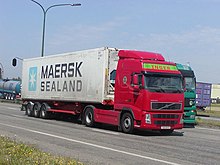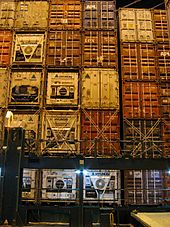Refrigerated container: Difference between revisions
m Added lower temperature applicable to super-freezers (-65C) |
|||
| Line 30: | Line 30: | ||
title=History| |
title=History| |
||
work=Cryo-Power Enterprises LLC| |
work=Cryo-Power Enterprises LLC| |
||
url=http://containerserviceco.com/history.html |
url=https://web.archive.org/web/20090627104857/http://www.containerserviceco.com/history.html |
||
}}</ref> Since they do not require an external power supply, cryogenically refrigerated containers can be stored anywhere on any vessel that can accommodate "dry" (un-refrigerated) ocean freight containers. |
|||
==Redundant refrigeration== |
==Redundant refrigeration== |
||
Revision as of 19:09, 19 May 2015
This article needs additional citations for verification. (December 2009) |


A refrigerated container or reefer is an intermodal container (shipping container) used in intermodal freight transport that is refrigerated for the transportation of temperature sensitive cargo.
While a reefer will have an integral refrigeration unit, they rely on external power, from electrical power points (“reefer points”) at a land based site, a
Some reefers are equipped with a water cooling system, which can be used if the reefer is stored below deck on a vessel without adequate ventilation to remove the heat generated (citation is needed, for example DNV GL or similar rules should be checked).
Water cooling systems are expensive, so modern vessels rely more on ventilation to remove heat from cargo holds, and the use of water cooling systems is declining (citation needed: there are vessels that uses water cooling due to fuel economy). Air cooling and water cooling are usually combined. Air cooling removes the heat generated by the reefers while water cooling helps to minimise the heat rejected by the refers. The reefers are using some heat exchangers that behaves as water cooled condensers: water cooling.
The impact on society of reefer containers is vast, allowing
Cryogenic cooling
Another refrigeration system sometimes used where the journey time is short is total loss refrigeration, in which frozen carbon dioxide ice (or sometimes liquid nitrogen) is used for cooling.[1] The cryogenically frozen gas slowly evaporates, and thus cools the container and is vented from it. The container is cooled for as long as there is frozen gas available in the system. These have been used in railcars for many years, providing up to 17 days temperature regulation.[2] Whilst refrigerated containers are not common for air transport, total loss dry ice systems are usually used.[1] These containers have a chamber which is loaded with solid carbon dioxide and the temperature is regulated by a thermostatically controlled electric fan, and the air freight versions are intended to maintain temperature for up to around 100 hours.[3]
Full size intermodal containers equipped with these "cryogenic" systems can maintain their temperature for the 30 days needed for sea transport.[2] Since they do not require an external power supply, cryogenically refrigerated containers can be stored anywhere on any vessel that can accommodate "dry" (un-refrigerated) ocean freight containers.
Redundant refrigeration

Valuable, temperature-sensitive, or hazardous cargo often require the utmost in system reliability. This type of reliability can only be achieved through the installation of a redundant refrigeration system.
A redundant refrigeration system consists of integrated primary and back-up refrigeration units. If the primary unit malfunctions, the secondary unit automatically starts. To provide reliable power to the refrigeration units, these containers are often fitted with one or more diesel generator sets.
Containers fitted with these systems may be required for transporting certain
Reefer types and dimensions
The reefer cannot be loaded in double-stack on rail flatcar.
See also
References
- ^ a b "Refrigerated transport: progress achieved and challenges to be met" (PDF). International Institute of Refrigeration. August 2003. Retrieved 2010-05-01.
- ^ a b "History". Cryo-Power Enterprises LLC.
- ^ Refrigerated container with temperature control RKN series and RAP series Operation manual (PDF). Envirotainer Engineering. August 2001. Retrieved 2010-05-01.

